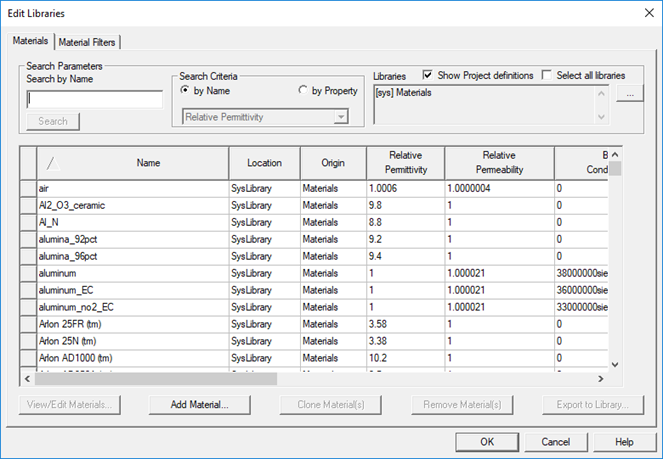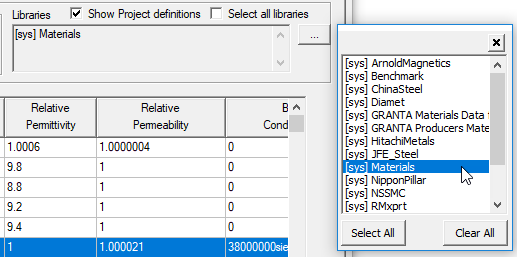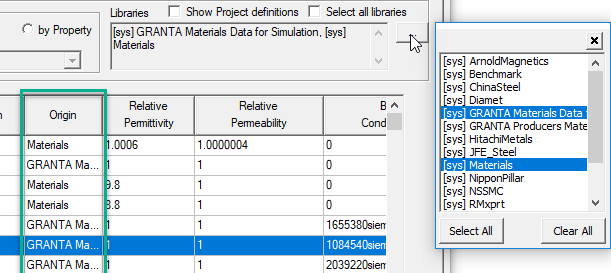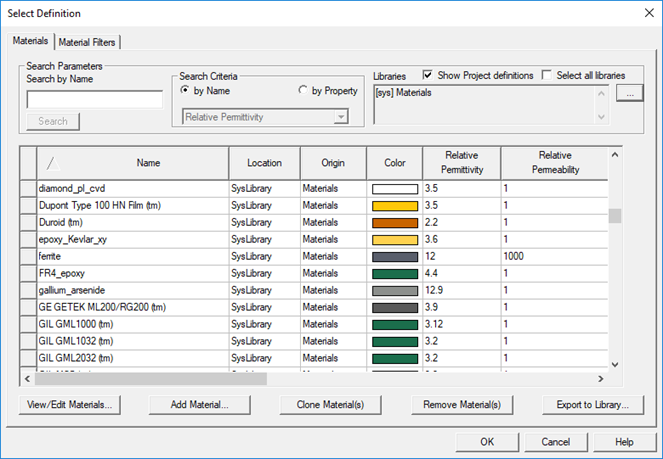Assigning Materials
You can add, remove, and edit materials in two main ways:
- Using the Tools > Edit Libraries > Materials menu command.
- Right-clicking Materials in the Project Manager tree and selecting Edit Library.
Regardless of which of the preceding two methods you use to edit a library, any new material you create exists only in the current project. Similarly, if you edit an existing material, the edited version becomes a Project material and exists only within the current project. To make a new or modified material available for other projects, you must export it to a user library and choose that library (or select Show all libraries) within the Select Definition dialog box.
To assign a material to an object, follow the general procedure:
- Select the object to which you want to assign a material.
-
Click Modeler > Assign Material
 or select the Material field in the Properties window for the selected object, and select Edit... from the drop down menu.
or select the Material field in the Properties window for the selected object, and select Edit... from the drop down menu.
The Select Definition window appears. The current material is highlighted, with the Name, Location, Origin library, and parameter values shown.

When the Select all libraries check box is selected, the window lists all of the materials in Ansys Electronics Desktop’s global material library as well as the project’s local material library.

If you click the ellipsis button [...], you see a list of all available libraries. Any selected libraries are highlighted. Shift-Click allows you select a range. Ctrl-Click allows you to select any libraries.

The Origin column shows the originating library for each material, whether the sys library, or one of the additional libraries listed in the Libraries pane.

For further information on the materials and their intended uses, you can refer to the published information on materials from those libraries. For example, the Schott materials are described in detail in the Wily Series in Materials for Electronic & Optoelectronic Applications, Microwave Dielectric Materials and Applications, edited by M. T. Sebastian, Rick Ubic, and Heli Jantunen, volumes 1 and 2.
The GRANTA Materials Data for Simulation are an optional, licensed feature, including more than 700 generic materials and 500 producer-specific magnetic materials. When you use or view the GRANTA licensing libraries, the GRANTA license is checked out and held for 30 minutes. Viewing the contents of a GRANTA library in the Materials dialog or modifying an object to use a GRANTA material causes a license check out and hold. If the license is already checked out, the hold time is reset to 30 minutes.
- In the Properties dialog box for the object, click the material name under the Attributes tab. A drop-down menu shows an Edit... button that opens the Select Definition window.
-
With an object selected in the Modeler window, on the Draw ribbon, select the Material icon.

- Right-click Model in the project tree, and then click Assign Material on the shortcut menu.
- Right-click the object in the history tree, and then click Assign Material on the shortcut menu.
- Select a material from the list.
- Click OK.
You can also open the Select Definition window in one of the following ways:
The menu also lists materials included in the current project. Selecting one of these materials provides another way to assign materials to an object.
The list displays the currently set values for many of a material’s properties such as Relative Permeability, Bulk Conductivity, and Composition. If the material you want to assign is not listed, you can add a new material to the global or local material library, and then select it.
The material you chose is assigned to the object.
If you have checked Show Material Colors on the Material Filters tab, the Materials tab includes a column showing a color swatch for each listed material.

You can edit the color and transparency values for materials in the View/Edit Material dialog.
Related Topics
Viewing and Modifying Material Attributes
Exporting Materials to a Library
Calculating Properties for Core Loss (BP Curve)
Calculating Properties for Temperature-Dependent Core Loss Curves in Maxwell
Defining Variable Material Properties
Defining Material Properties as Expressions
Defining Functional Material Properties
Autocomplete for Variables and Properties in Electronics Desktop
Importing and Converting Materials
Working with Material Libraries
